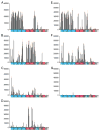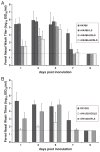Effect of receptor binding domain mutations on receptor binding and transmissibility of avian influenza H5N1 viruses
- PMID: 21397290
- PMCID: PMC5470842
- DOI: 10.1016/j.virol.2011.02.015
Effect of receptor binding domain mutations on receptor binding and transmissibility of avian influenza H5N1 viruses
Abstract
Although H5N1 influenza viruses have been responsible for hundreds of human infections, these avian influenza viruses have not fully adapted to the human host. The lack of sustained transmission in humans may be due, in part, to their avian-like receptor preference. Here, we have introduced receptor binding domain mutations within the hemagglutinin (HA) gene of two H5N1 viruses and evaluated changes in receptor binding specificity by glycan microarray analysis. The impact of these mutations on replication efficiency was assessed in vitro and in vivo. Although certain mutations switched the receptor binding preference of the H5 HA, the rescued mutant viruses displayed reduced replication in vitro and delayed peak virus shedding in ferrets. An improvement in transmission efficiency was not observed with any of the mutants compared to the parental viruses, indicating that alternative molecular changes are required for H5N1 viruses to fully adapt to humans and to acquire pandemic capability.
Copyright © 2011 Elsevier Inc. All rights reserved.
Conflict of interest statement
The authors wish to report no competing interests associated with this manuscript.
Figures



References
-
- Blixt O, Head S, Mondala T, Scanlan C, Huflejt ME, Alvarez R, Bryan MC, Fazio F, Calarese D, Stevens J, Razi N, Stevens DJ, Skehel JJ, van Die I, Burton DR, Wilson IA, Cummings R, Bovin N, Wong CH, Paulson JC. Printed covalent glycan array for ligand profiling of diverse glycan binding proteins. Proc Natl Acad Sci USA. 2004;101(49):17033–17038. - PMC - PubMed
-
- Chandrasekaran A, Srinivasan A, Raman R, Viswanathan K, Raguram S, Tumpey TM, Sasisekharan V, Sasisekharan R. Glycan topology determines human adaptation of avian H5N1 virus hemagglutinin. Nat Biotechnol. 2008;26(1):107–113. - PubMed
-
- Chutinimitkul S, van Riel D, Munster VJ, van den Brand JM, Rimmelzwaan GF, Kuiken T, Osterhaus AD, Fouchier RA, de Wit E. In vitro assessment of attachment pattern and replication efficiency of H5N1 influenza A viruses with altered receptor specificity. J Virol. 2010;84(13):6825–6833. - PMC - PubMed
-
- Connor RJ, Kawaoka Y, Webster RG, Paulson JC. Receptor specificity in human, avian, and equine H2 and H3 influenza virus isolates. Virology. 1994;205(1):17–23. - PubMed
-
- Couceiro JN, Paulson JC, Baum LG. Influenza virus strains selectively recognize sialyloligosaccharides on human respiratory epithelium; the role of the host cell in selection of hemagglutinin receptor specificity. Virus Res. 1993;29(2):155–165. - PubMed
Publication types
MeSH terms
Substances
Grants and funding
LinkOut - more resources
Full Text Sources
Other Literature Sources
Medical

